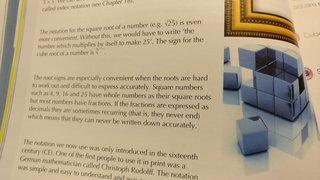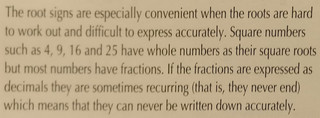
My latest posts can be found here: Previous blog posts:
Additionally, some earlier writings: |
The book is not always rightRecently someone tweeted a picture of a page from a book. It seems to be some sort a book about maths aimed at students, but in one simple paragraph there was just so much wrong, it attracted many comments from many of my friends and colleagues. But then someone I follow on twitter asked why it was so bad, and could it be explained to someone with no more than A-Level maths, and so I thought I'd give that a go. Here is my explanation.
Before I start, here's a comment prompted by one of my readers. My non-mathematical reader might look at all of this and think of it as unimportant pedantry. But I think it's important to hear this message. The sense sometimes is that something might be technically wrong, but "close enough for Government work," but that view can be damaging and have life-long effects. The skills to think deeply, clearly, carefully, accurately, and precisely about things is becoming more and more important, and those skills are exactly those honed by doing mathematics. So many "proofs" are wrong because someone didn't consider a negative square root, or didn't think hard enough about whether something was a rational or an irrational. If you don't form and reinforce the intuition that negatives are square roots, or that fractions and irrationals are very much not the same thing, you generate mathematicians whose instincts go against their own work. Not everyone will be a mathematician, agreed, but the skills are eminently transferrable.
Here is the original text:
The problem here is just how to unpack everything that is wrong, while at the same time remaining accurate, but brief. Being absolutely exact about these things can be rather overwhelming. However, here we go. Firstly, a technical term. In maths the word "Integer" is used to mean "whole number", both positive and negative, as well as zero. So the integers are the numbers:
The "square root" of a number $T$ is a number $x$ such that $x^2=T$. In words, it's a number which when multiplied by itself results in the target we want. Thus the square root of 25 is 5. But we need to be careful. I've said "the" square root, but in fact the number $-5$ also squares to give 25. By convention when we talk about square roots we usually mean the positive square root. There are conventions, and usually they don't matter much. In those cases where they do matter, usually the people involved know about the various nuances, and take care to make things clear. In this post I'll stick with the positive numbers, because it's enough to address the points arising. So we observe that some integers, such as 1, 4, 9, 16, and 25, have integers as their square roots. In fact each of these has two square roots, the positive and the negative. So 16 has two square roots, -4 and 4, but as commented above, we'll stick with the positive numbers in this post. But fairly clearly there are numbers that do not have integer square roots. A classic example of this is 2. The integer 2 does not have an integer as its square root. This is easy to see because squaring 0, 1, or -1 does not give an answer of 2, and all integers less than -1 or greater than 1 have squares that are greater than 2. So now we're in a position to look at the first sentence:
So we've dealt with [0], that's uncontroversial.
However, to be generous in our interpretation, we can look at the positive integers up to some limit, say 1000, and then ask what proportion are square numbers, and in this finite case, clearly most numbers are not square numbers. So when interpreted in this sense, statement [1] makes sense, and is not wrong. The problem is that it's skirting very close to something that is wrong, and it's certainly going down a line that leads people to say things that definitely are wrong. It's really easy to say things about "infinity" that seem reasonable and intuitively right, but are at the least troubling, and often downright inconsistent. But point [2] really is simply wrong. We know this:
The proof of this is fairly straight-forward, but is not in the scope of this post. The point is, statement [2] is quite simply wrong, and badly so. So now we turn to the second sentence:
We assume that point [3] is talking about the "fractions" that result from the square root of a non-square integer, although we know that they cannot be fractions. But let's assume that the things being discussed are the square roots of non-square integers.
So the square roots of non-square integers are never fractions, and are therefore never recurring. Point [5] equates "recurring" with "never ending". But consider this decimal squence:
Finally, point [6] is just as confused. The fraction $\frac{1}{7}$ has a decimal expansion of:
So the real howler here is to claim that the square roots of non-square integers are fractions, and the rest of it just doubles down to show quite a lot of muddled thinking and sloppy writing. Does it matter? I'd say yes.
AcknowledgementsMy thanks to Adam Rosenthal for the initial question, and for follow-up clarifications, etc, and to Neil Calkin (Twitter) and Alun Jones (Twitter, Web site) for additional comments and feedback.
Send us a comment ...
|



 Suggest a change ( <--
What does this mean?) /
Send me email
Suggest a change ( <--
What does this mean?) /
Send me email